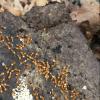I got a P. Imparis for another member and noticed a bit of mold starting to form on the cotton ball in the test tube around the edges. She's on a bit of a restart as she was in with other queens he said originally, and didn't really move out of her test tube with the rest of them/workers. He separated her and she started laying again in her tube, and he gave her to me. I connected a new tube, surrounded it in aluminum foil, covered it with a padded envelope as well so it's dark. I put her underneath the light as I've read tips on. However she literally picked up at least one of the visible eggs on the side, moved it to the middle of the cotton ball and refuses to budge after a few days (doesn't seem phased really by light at all.) Any other suggestions to getting her to move and potentially bringing her brood with her?
My concern is that if she did indeed restart laying after a bad start this season, not sure if she's up for a 3rd restart of laying if I just forced her over. I really have wanted one of these queens for awhile, so really hoping not to overstress her...
My other thought was if the mold isn't bugging her, just leave her alone in the dark for a couple weeks and just see what happens...
Thanks!

















